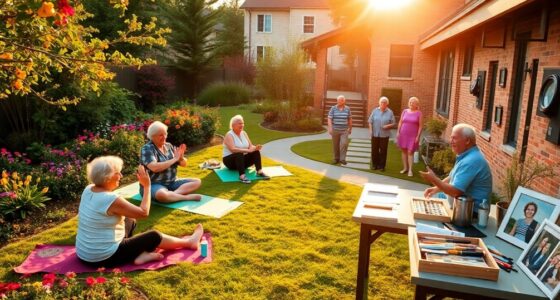Many seniors are beating loneliness by using technology like telehealth and virtual apps to stay connected with mental health professionals and loved ones. They also participate in community activities, social groups, and hobbies to build meaningful relationships. Combining online support with real-world engagement creates a strong network against isolation. If you explore further, you’ll discover how these approaches can help you or your loved ones thrive with improved well-being.
Key Takeaways
- Telehealth enables seniors to access mental health support remotely, reducing transportation barriers and stigma.
- Community engagement through local clubs and social activities fosters meaningful connections and emotional resilience.
- Interactive technologies like virtual reality and social media enhance social interaction and mental stimulation.
- Combining telehealth with community involvement offers a comprehensive approach to combating loneliness.
- Regular social interactions and virtual support networks help seniors maintain mental well-being and reduce isolation.

Have you ever wondered how mental health impacts seniors’ overall well-being? As you age, maintaining good mental health becomes increasingly essential, especially when loneliness and social isolation threaten your quality of life. Fortunately, advances in technology and community initiatives are helping seniors combat these challenges effectively. One key tool is telehealth access, which allows you to connect with mental health professionals from the comfort of your home. No longer do you need to worry about transportation issues or mobility limitations; instead, you can schedule virtual appointments that fit your busy schedule. Telehealth not only makes mental health support more accessible but also reduces the stigma that often surrounds seeking help. Through video calls, you can express your concerns, receive guidance, and develop coping strategies without leaving your living room.
But technology alone isn’t enough. Community engagement plays a fundamental role in easing loneliness among seniors. Participating in local clubs, volunteer groups, or social activities helps you forge meaningful connections with others who share your interests. These interactions can boost your mood, provide a sense of belonging, and remind you that you’re not alone. Many communities are now organizing senior-friendly events, both online and in person, making it easier for you to stay involved. When you engage with others regularly, whether through a book club, hobby group, or neighborhood walk, you create a support network that can help you navigate mental health challenges. These social bonds are proven to reduce feelings of isolation and promote emotional resilience. Additionally, incorporating interactive technology such as virtual reality or social media platforms can further enhance social connections and mental stimulation.
Combining telehealth access with community engagement creates a powerful strategy for seniors to beat loneliness. Imagine attending a virtual support group that’s also linked to local community events, giving you multiple avenues for connection. With telehealth, you can discuss feelings of loneliness with a counselor, while community activities provide real-world interactions that reinforce your social ties. This integrated approach helps you stay mentally healthy, active, and engaged, fostering a sense of purpose and joy. It’s important to remember that reaching out for help isn’t a sign of weakness, but a essential step toward thriving in later years. By embracing technology and community involvement, you’re taking control of your mental health and setting a positive example for others in your age group. You don’t have to face loneliness alone—there are resources and people ready to support you every step of the way.
Frequently Asked Questions
How Does Loneliness Affect Seniors’ Physical Health Long-Term?
Loneliness can seriously impact your long-term physical health by increasing risks of chronic illness and weakening your immune system. When you experience social isolation, your body responds with stress hormones that can lead to high blood pressure and heart disease. Over time, this can make you more vulnerable to illnesses, reduce your mobility, and diminish your overall well-being. Staying connected helps you protect your health and combat these negative effects.
What Role Do Pets Play in Reducing Senior Isolation?
You might find that companion animals play a big role in reducing senior isolation. Pets provide emotional support and companionship, helping seniors feel less lonely. They encourage daily routines and social interactions, which boost mood and mental well-being. With a pet around, you get a loyal friend who offers comfort and joy, making it easier to stay connected and engaged even when social opportunities are limited.
Are There Specific Technology Tools to Help Seniors Stay Connected?
You can use technology tools like video calling apps for virtual communication, which help seniors stay connected with loved ones easily. Social networking platforms tailored for seniors also promote interaction and community engagement. These tools make it simple for you to share moments, chat, and stay informed, reducing feelings of loneliness. Embracing such technology encourages ongoing social connections, ensuring you remain engaged and emotionally supported.
How Can Communities Better Support Lonely Seniors?
You can help lonely seniors by fostering community engagement through local events and social activities. Encourage volunteer programs that connect seniors with caring volunteers, offering companionship and support. Reach out regularly, invite them to participate, and promote inclusive spaces where they feel valued. Your active involvement creates a sense of belonging, helping seniors overcome loneliness and stay connected, enriching their lives and strengthening community bonds.
What Mental Health Therapies Are Most Effective for Seniors?
You should consider engaging seniors in group therapy, which fosters social connections and shared understanding, boosting mental health. Art therapy also proves effective, allowing expression and emotional release through creative activities. Both approaches help seniors manage issues like depression and anxiety. By encouraging participation in these therapies, you support their mental well-being, making them feel less isolated and more connected to their community.
Conclusion
As you walk through the quiet streets of a community that’s come alive with shared stories and warm smiles, you realize that connection is the true remedy for loneliness. Seniors, like sturdy trees standing firm against the wind, find strength in companionship and purpose. When you reach out, you’re planting seeds of hope in a garden of resilience, turning isolated shadows into vibrant mosaics of life. Together, you create a world where no one has to face loneliness alone.









